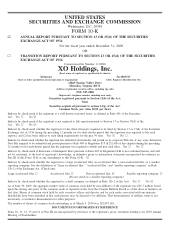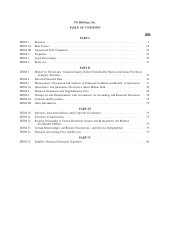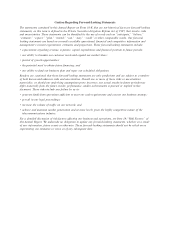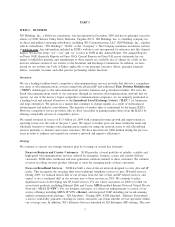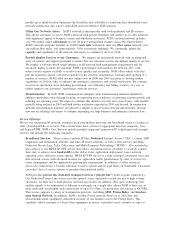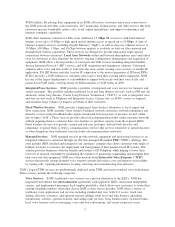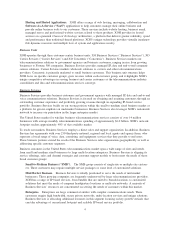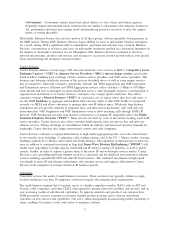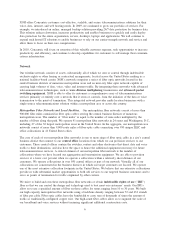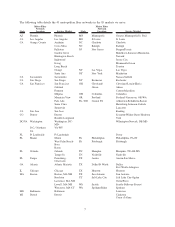XO Communications 2009 Annual Report Download - page 9
Download and view the complete annual report
Please find page 9 of the 2009 XO Communications annual report below. You can navigate through the pages in the report by either clicking on the pages listed below, or by using the keyword search tool below to find specific information within the annual report.
Government. Government entities from local school districts to state offices and federal agencies
frequently require telecommunications solutions that are similar to mid-market and enterprise businesses.
Yet, government customers have unique needs and purchasing processes necessary to meet the require-
ments of serving the public.
Historically, Business Services has served a portion of all these groups, with an especially strong presence in
the SMB market. During 2008, Business Services began shifting its focus to mid-market business enterprises.
As a result, during 2008 a significant shift in expenditures, personnel and customer base occurred. Business
Services’ concentration of resources and focus on mid-market businesses resulted in a substantial expansion in
the number of mid-market customers served. Throughout 2009, Business Services continued to invest in
network infrastructure, products and services, and resources to accelerate revenue growth with an even greater
focus on penetrating the enterprise customer market.
Carrier Services
Carrier Services delivers a broad range of IP, data and wholesale voice services to ILECs, Competitive Local
Exchange Carriers (“CLEC“s), Internet Service Providers (“ISPs”), interexchange carriers, non-facility
based resellers, building local exchange carriers, wireless service providers, and VoIP service providers. This
business unit leverages wholesale versions of the services described above as well as some unique services
that are targeted to wholesale customers, specifically, ethernet and TDM Aggregation and VoIP Origination
and Termination services. Ethernet and TDM Aggregation services collect end-user 1.5 Mbps to 100 Mbps
from discrete end user or enterprise locations distributed across a wide geographic region at a metropolitan or
regional level and delivers it to Carrier Services’ customers over a larger speed connection. This allows
customers without a Point-of-Presence (“POP”) in a particular city or region where they have end-users, to
use the XOH backbone to aggregate and backhaul their end user traffic to their POP. Traffic is transported
securely via MPLS and allows customers to manage their own IP address space. Wholesale long distance
termination services provide solutions to terminate inter- and intra-state long distance calls with only one
interconnection. VoIP Origination and VoIP Termination services allow incoming calls through XOH’s IP
network. VoIP Termination provides long distance connectivity to terminate IP-originated calls to the Public
Switched Telephone Network (“PSTN”). These services are used by some of the nation’s leading retail VoIP
service providers. Carrier Services also offers customers high-capacity, inter-city private line and inter-city
ethernet services. Taking advantage of consolidation within the industry and increased customer demands for
bandwidth, Carrier Services also targets international carriers and cable companies.
Carrier Services continues to expand infrastructure to high-traffic aggregation points across the United States
in two specific areas including: 1) submarine cable landing stations; and 2) the US — Mexico border crossing,
enabling connectivity to Mexico and Central and South America. The expansion of infrastructure in these two
areas in addition to continued investment in long-haul Dense Wave Division Multi-plexing (“DWDM”) will
enable more opportunity for high capacity bandwidth and IP services among US domestic as well as global
carriers. Further, in order to capture a greater share of the metro IP and wavelength services market, Carrier
Services is now providing mid-band ethernet services to customers and has deployed next-generation ethernet
services enabling expanded IP-VPN and other IP-based services. The combined investments in high speed
wavelength in metro IP and ethernet technologies and customer service and support, differentiates Carrier
Services from competitors for future wholesale IP business growth.
Concentric
Concentric services the needs of small business customers. These customers are typically defined as single
location businesses, less than 20 employees, with non-complex telecommunications requirements.
The small-business segment that Concentric serves is a highly competitive market. ILECs such as ATT and
Verizon, cable companies, and other CLECs offer aggressive pricing, innovative products and services, and an
ever increasing toolkit of self-directed capabilities. To improve retention and growth of our customer base,
XOH proactively contacts customers to promote bundled product packages and to educate and inform
customers on new services and capabilities. Our active churn management programs help predict propensity to
churn, enabling Concentric to take swift action to minimize attrition.
5


